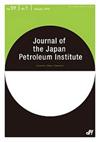Heat and Mass Transfer of Internally Heat Integrated Distillation Column (HIDiC)
IF 0.6
4区 工程技术
Q4 ENERGY & FUELS
引用次数: 4
Abstract
Distillation is the most frequently-used separation process in the chemical industry. Distillation columns account for about 40 % of the total energy consumption in chemical plants, so energy savings in distillation processes are highly desirable. Internally heat integrated distillation columns (HIDiC) are one of the most promising alternatives to conventional distillation columns. Our present design of HIDiC has a similar structure to a heat exchanger (Fig. 1). In the HIDiC, the distillation column is divided into two parts, rectifying and stripping sections. The pressure in the rectifying section is raised by compressing the vapor flow from the top of the stripping section. Physical contact between all or part of the rectifying section with the stripping section then allows internal heat exchange. If the temperature of the rectifying section is appropriately higher than that of the stripping section, the residual heat in the rectifying section can be used as a heat source for the stripping section, resulting in lower requirement for reboiler heat. At the same time, the vapor and the liquid flow rates in the rectifying section are decreased towards the top due to the condensation caused by the internal heat exchange, resulting in reduction of the external reflux ratio. The idea of the HIDiC was first proposed by Haselden for energy savings in cryogenic air separation1). Later the idea was reintroduced by Mah et al.2), and the outline of the present design of the HIDiC was established. In Japan, the fundamentals and practical application of the HIDiC have been studied by Takamatsu et al.3) since the 1980’s. Their great efforts have lead to construction of prototypes and pilot plants of the HIDiC. In particular, the HIDiC pilot plant in Maruzen Petrochemical Co., Ltd. has succeeded in 189 Journal of the Japan Petroleum Institute, 58, (4), 189-196 (2015)内热集成精馏塔(HIDiC)的传热传质
蒸馏是化学工业中最常用的分离过程。精馏塔约占化工装置总能耗的40%,因此精馏塔的节能是人们迫切需要的。内热集成精馏塔(HIDiC)是传统精馏塔最有前途的替代品之一。我们目前设计的HIDiC具有与热交换器相似的结构(图1)。在HIDiC中,精馏塔分为精馏和汽提两部分。通过压缩汽提段顶部的蒸汽流来提高精馏段的压力。所有或部分精馏段与汽提段之间的物理接触允许内部热交换。如果精馏段的温度适当高于汽提段的温度,则可以利用精馏段的余热作为汽提段的热源,从而降低对再沸器热量的要求。同时,由于内部热交换引起的冷凝,使整流段的汽液流量向顶部减小,导致外部回流比减小。HIDiC的想法最初是由Haselden提出的,目的是为了在低温空气分离中节约能源。后来,Mah等人重新引入了这个想法2),并建立了当前HIDiC设计的轮廓。在日本,自20世纪80年代以来,Takamatsu等人一直在研究HIDiC的基本原理和实际应用。他们的巨大努力导致了HIDiC原型和试验工厂的建设。特别是,Maruzen石化公司的HIDiC中试装置取得了成功[j] .日本石油学院学报,58,(4),189-196(2015)。
本文章由计算机程序翻译,如有差异,请以英文原文为准。
求助全文
约1分钟内获得全文
求助全文
来源期刊

Journal of The Japan Petroleum Institute
工程技术-工程:石油
CiteScore
1.70
自引率
10.00%
发文量
29
审稿时长
>12 weeks
期刊介绍:
“Journal of the Japan Petroleum Institute”publishes articles on petroleum exploration, petroleum
refining, petrochemicals and relevant subjects (such as natural gas, coal and so on). Papers published in this journal are
also put out as the electronic journal editions on the web.
Topics may range from fundamentals to applications. The latter may deal with a variety of subjects, such as: case studies in the development of oil fields, design and operational data of industrial processes, performances of commercial products and others
 求助内容:
求助内容: 应助结果提醒方式:
应助结果提醒方式:


